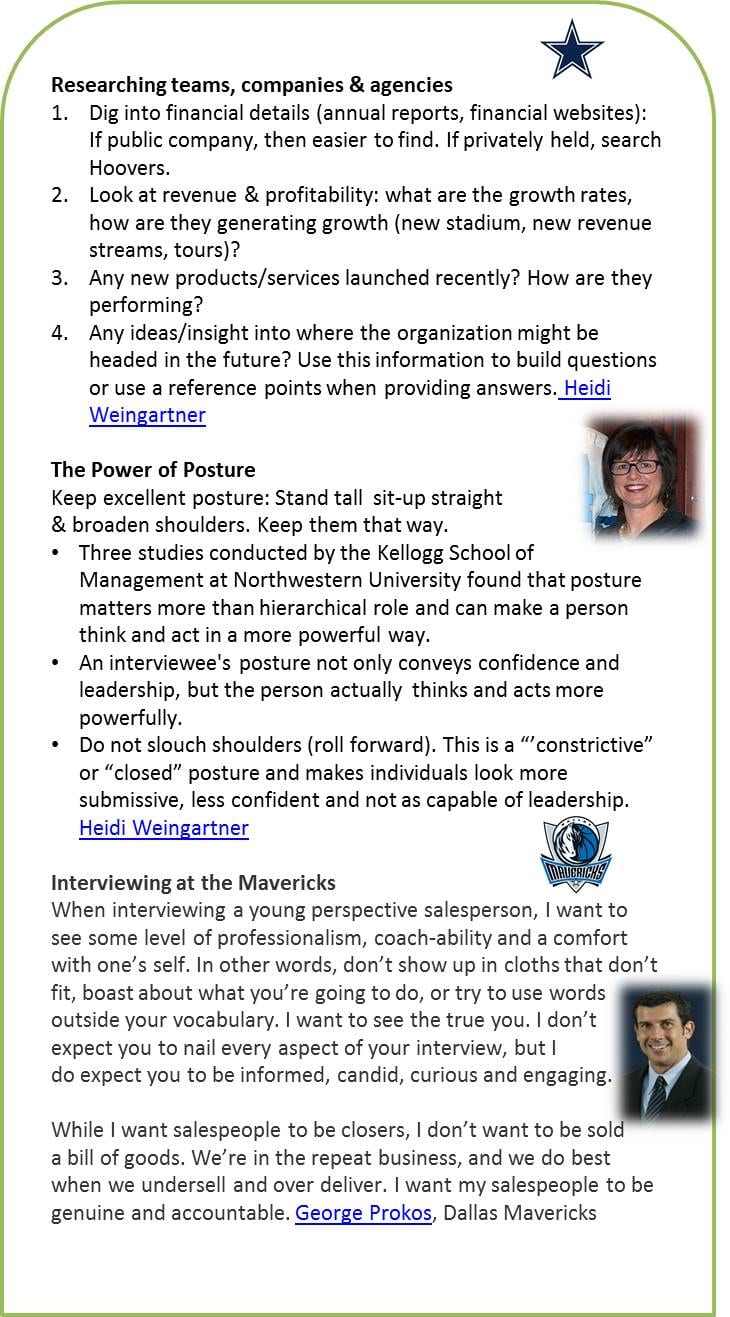by Jeannette Salas – February 2013
We covered how to get the interview here. Now you’ve made it to the face-to-face (virtual) interviews. What do you need to do be prepared?
Preparation
- Research. Thoroughly research the organization prior to interview.
- How is the team marketing and advertising?

Insights from Heidi Weingartner, Chief HR Office at the Dallas Cowboys and George Prokos, Former Sr. VP of Ticket Sales and Services at the Dallas Mavericks. - How are they involved in the community?
- Who are the C-level executives and managers?
- Know their names and positions.
- Look up their backgrounds/bios (team website, Google; LinkedIn)
- How is the team marketing and advertising?
- Questions. Come up with at least five questions to ask about corporate culture, likes/dislikes, challenges, etc. Why? Good questions:
- Should be written down.
- Show interest.
- Allow you to get FREE valuable information from someone in your career choice on how to move up and be successful in your career.
The best question a candidate asked me was, “What do you like and not like about your position?” Asked sincerely, this question showed a personal interest in me and what goes on here every day.
The interview
How important is this interview to you? If you are selected from the 100’s of resumes received, I’m assuming it should be important to you. Some of these tips are for in-person interviews, but apply the same principles for virtual interviews.
- Attire: Dress professionally (suits). More on making the best first impression in the next column.
- If in-person: Arrive 10-15 minutes early. Don’t show up an hour or two early.
- Turn off your phone before the interview.
- No, turn it off. Silent is not good enough.
- Be ready to go once you step outside of the car.
- Have your hair and/or makeup done before arriving.
- Put your jacket on before you exit the car.
- You don’t know who’s watching or who you’ll meet when or where along the way.
- For virtual interviews:
- Make sure whatever is in camera view sends the right signals.
- Don’t locate in a noisy room.
- Dress like you were doing an in-person interview (suits).
- Have a padfolio and pens (and extra copies of your resume if in-person).
- Some employers intentionally “forget” to bring your resume to the interview.
- Someone may forget a pen.
- Be prepared.
- SMILE!!! Everyone is watching you.
- That person you don’t think is watching is the person who talks to the manager right after you leave.
- Beware of windows – people like to observe and will give feedback.
- Be courteous. Yes, the receptionist counts. Double.
- Exude confidence.
- Firm handshake.
- Clear greeting, by last name (Mr. Smith). Do not be overly familiar until they say so.
- Make eye contact during interview. (But, don’t stare the person down.)
- Relax and be yourself, but remain professional regardless of interviewer’s professionalism.
- Removing jacket, unbuttoning tie, etc. is not acceptable.
- Be personable, but not overly excited.
- Keep an engaged, positive posture – no slouching.
- Don’t stare.
- Don’t fidget: Biting nails, playing with hair, tapping pen, cracking knuckles, etc.
- Stay focused.
- Listen to what is being asked and answer the question.
- Ask for clarification if you don’t understand question.
- Don’t ramble.
- Be confident in your answers:
- Don’t answer with an upswing inflection, where the cadence of the voice rises as though every sentence ends in a question mark.
- Be accountable. Everyone makes mistakes!!!!! Explain what you learned from mistakes and what you did to ensure it was not repeated.
- Be able to explain gaps in employment clearly.
- Never bash former employers or colleagues. This gives a clue as to how you might view your next employer and colleagues.
Closing the Interview
If you are interviewing for a sales position, they are looking for someone who can close a deal.
- Close the interview.
- Highlight why you are the best candidate for the position based on the needs identified during the interview.
- Show how your strengths make you a good fit for the position.
- Show enthusiasm!!!!
- Thank interviewers for their time and again give firm handshakes.
- Say goodbye to the receptionist by name (s/he always counts).
Next time we’ll cover in more detail steps to success getting jobs in professional sports, including specific do’s and don’ts of professional attire for interviewing, as well as resumes, follow-up, and cover letters.
